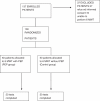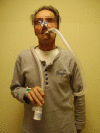Use of positive expiratory pressure during six minute walk test: results in patients with moderate to severe chronic obstructive pulmonary disease
- PMID: 23497658
- PMCID: PMC3637106
- DOI: 10.1186/2049-6958-8-19
Use of positive expiratory pressure during six minute walk test: results in patients with moderate to severe chronic obstructive pulmonary disease
Abstract
Background: The six-minute walk test (6MWT) is widely used because it is both simple and reliable as a measure of exercise capacity. Individuals with chronic obstructive pulmonary disease (COPD) usually show a limited capacity to perform exercise.
Methods: Our study is a prospective, randomized controlled trial which uses the 6MWT in one hundred consecutive in and out- patients with moderate to severe COPD to assess the benefit of a simple positive expiratory pressure (PEP) device. PEP device consisted of a PEP valve 5 cmH2O connected to 1-meter tube and a mouthpiece. All the enrolled patients performed a 6MWT before randomization. The following day PEP group patients performed the 6MWT using PEP device. Control group patients performed the 6MWT without this device. The primary outcome was the difference in distance (meters) walked.
Results: Functional capacity assessed by the distance covered during 6MWT improved in the PEP group more than in the control group. The difference was statistically significant (p < 0.001).Oxygen saturation improved to a statistically significant level during 6MWT (p < 0.01). Heart rate was also reduced (p < 0.03).
Conclusions: There are few studies demonstrating that PEP devices enhance exercise capacity in COPD patients. Our results has been obtained using only a low positive expiratory pressure (5 cmH2O). In our opinion the strength of this study is the simplicity and the lower cost when compared to other devices and approaches. The study was registered as Chi CTR-ORC-12002173 at http://www.chictr.org.
Figures




References
LinkOut - more resources
Full Text Sources
Other Literature Sources
Medical
Miscellaneous

